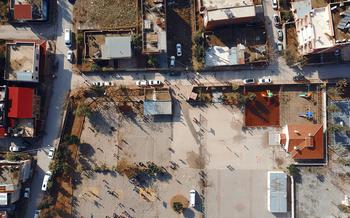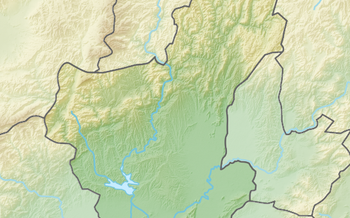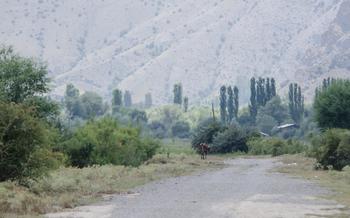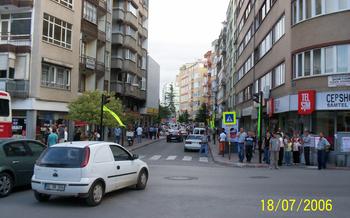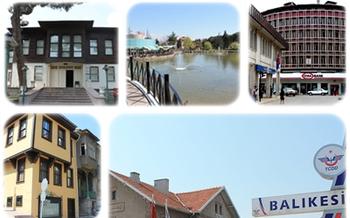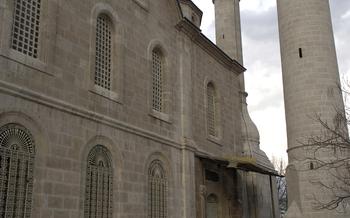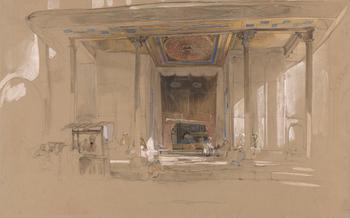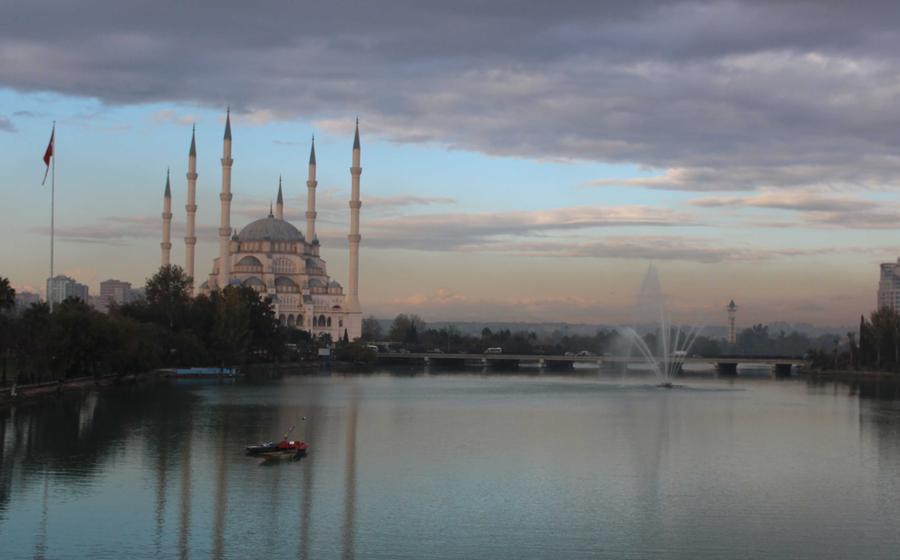
Adana Merkez Camii (Central Mosque)
- Adana Merkez Camii (Central Mosque): A Masterpiece of Islamic Architecture
- Exploring the Grand Prayer Hall
- Witnessing the Call to Prayer
- Admire the Stunning Minarets
- Panoramic Views from the Minarets
- Symbolism and Significance of the Minarets
- Discover the History of the Mosque
- Unveiling the Architectural Details
- Experience the Spiritual Atmosphere
- Learn about Islamic Traditions
- Attend Congregational Prayers
- Explore the Surrounding Area
- Capture Memorable Moments
- Interact with the Locals
- Respectful Attire and Behavior
- Plan Your Visit
- Insider Tip: Unveiling the Hidden Gem
Adana Merkez Camii (Central Mosque): A Masterpiece of Islamic Architecture
Adana Merkez Camii, also known as the Adana Central Mosque, stands as a testament to the rich Islamic heritage of Turkey. Its history dates back to the early 16th century, when it was commissioned by the Ottoman sultan Suleiman the Magnificent. The mosque holds a significant position in the hearts of the local community, serving as a spiritual and cultural hub for Muslims in Adana.
Architecturally, the Adana Merkez Camii is a stunning blend of Ottoman and Seljuk styles. Its exterior facade is adorned with intricate carvings, tiles, and calligraphy, showcasing the artistry and craftsmanship of the era. The interior of the mosque is equally impressive, with a vast prayer hall that can accommodate thousands of worshippers. The grand dome, supported by elegant pillars, creates a sense of awe and grandeur.
Beyond its architectural beauty, the Adana Merkez Camii plays a crucial role in the local community. It serves as a center for Islamic learning and practices, with regular sermons, classes, and religious ceremonies held within its walls. The mosque also hosts community events and gatherings, fostering a sense of unity and belonging among the Muslim population of Adana.
Exploring the Grand Prayer Hall
The grand prayer hall of the Adana Merkez Camii is a breathtaking spectacle, capable of accommodating thousands of worshippers within its vast expanse. Its sheer size and scale evoke a sense of awe and reverence, inviting visitors to immerse themselves in the spiritual atmosphere.
The interior of the prayer hall is a symphony of intricate designs and decorations, showcasing the finest craftsmanship of Islamic art. The walls are adorned with intricate tilework, featuring vibrant colors and geometric patterns that dance in the light. The ceiling is a masterpiece of calligraphy, with verses from the Quran gracefully inscribed in flowing Arabic script.
The atmosphere within the prayer hall is one of profound spirituality and religious devotion. As worshippers gather for their daily prayers, the air fills with the rhythmic chanting of verses from the Quran, creating a harmonious and soul-stirring melody. The faithful bow their heads in unison, their hearts united in prayer, reflecting the deep connection between the mosque and the local Muslim community.
Witnessing the Call to Prayer
In Islam, the call to prayer, known as the adhan, holds immense importance, summoning the faithful to congregate for their obligatory prayers. The Adana Merkez Camii's muezzin, with his melodious voice, delivers this sacred call from the towering minarets, echoing through the city's streets and reaching the hearts of believers.
The adhan is not merely a call to prayer; it is a declaration of faith, a reminder of God's greatness, and an invitation to experience the spiritual connection with the divine. As the muezzin's voice reverberates through the air, Muslims pause their daily activities and turn towards the mosque, their hearts filled with reverence and devotion.
For non-Muslim visitors, witnessing the call to prayer in Adana is a unique and awe-inspiring experience. The beautiful melodies, the intricate Arabic phrases, and the sheer power of the muezzin's voice create a captivating atmosphere that leaves a lasting impression. It is a moment to pause, reflect, and appreciate the beauty and diversity of religious traditions.
Admire the Stunning Minarets
The Adana Merkez Camii boasts four towering minarets that are a testament to the grandeur and architectural brilliance of Islamic architecture. Standing tall and majestic, these minarets are visible from various points in the city, serving as iconic landmarks that define the skyline of Adana.
The minarets are a remarkable feat of engineering, reaching an impressive height that allows the call to prayer to reverberate throughout the city, summoning worshippers to the mosque. Their intricate designs and elegant proportions showcase the exceptional craftsmanship and artistry of the builders.
Panoramic Views from the Minarets
Ascending to the top of the minarets is an unforgettable experience that offers breathtaking panoramic views of Adana. From this elevated vantage point, visitors can marvel at the city's sprawling cityscape, with its vibrant neighborhoods, lush green spaces, and the meandering Seyhan River flowing gracefully through the heart of the city.
The panoramic views from the minarets provide a unique perspective, allowing visitors to appreciate the harmonious blend of modern and traditional architecture, as well as the city's rich cultural heritage. The stunning vistas from atop the minarets make them a must-visit attraction for anyone seeking to capture the essence of Adana.
Symbolism and Significance of the Minarets
In Islamic architecture, minarets hold deep symbolic and religious significance. They serve as a visual representation of the faith's call to prayer, beckoning believers to come together for worship. The tall and slender form of the minarets symbolizes the connection between heaven and earth, representing the spiritual aspirations of the Muslim community.
The Adana Merkez Camii's minarets are adorned with intricate carvings and decorative elements that reflect the rich artistic traditions of the region. These embellishments add to the aesthetic beauty of the minarets, transforming them into captivating works of art that showcase the creativity and devotion of the mosque's builders.
Discover the History of the Mosque
The Adana Merkez Camii, also known as the Ulu Cami, has a rich and storied history that dates back to the early days of the Ottoman Empire. The original mosque was constructed in the 16th century by the order of the Ottoman Sultan Selim II. The mosque underwent several renovations and expansions throughout the centuries, reflecting the city's growing importance and wealth.
In the 19th century, the mosque was extensively renovated and expanded by the Ottoman Sultan Abdul Hamid II. During this renovation, the mosque's interior was decorated with intricate tilework and calligraphy, and the exterior was adorned with new minarets. The mosque's current form is largely the result of these renovations.
The Adana Merkez Camii has played a significant role in the city's cultural and religious development. It has served as a center for Islamic learning and practices, and has hosted numerous religious ceremonies and events throughout its history. The mosque has also been a place of refuge and solace for the people of Adana, offering them a place to worship, learn, and connect with their community.
Unveiling the Architectural Details
The Adana Merkez Camii stands as a testament to the harmonious blend of Ottoman and Seljuk architectural styles. Its exterior is adorned with intricate carvings, tiles, and calligraphy, each element carrying symbolic meaning and hidden messages. The grand entrance, framed by a majestic arch, invites visitors into a world of artistic wonders. Inside, the mosque's vast prayer hall is a symphony of elegant columns, intricate tilework, and stunning chandeliers. The mihrab, the sacred niche indicating the qibla (direction of prayer), is a masterpiece of Islamic art, featuring intricate carvings and colorful tiles. Every corner of the mosque reveals a new treasure, from the delicate stained-glass windows to the ornate calligraphy adorning the walls. These architectural details not only enhance the beauty of the mosque but also serve as reminders of the rich history and cultural heritage of Adana.
Experience the Spiritual Atmosphere
Stepping into the Adana Merkez Camii, visitors are immediately enveloped by a profound sense of peace and tranquility. The spacious prayer hall, with its high ceilings and elegant arches, creates a serene ambiance conducive to spiritual reflection and connection. The soft glow of natural light filtering through the stained-glass windows casts an ethereal aura, enhancing the sacred atmosphere within.
The devotion and reverence of the worshippers are palpable, as they gather in unison to offer their prayers. The rhythmic recitation of verses from the Quran fills the air, creating a harmonious melody that resonates with the faithful. The sense of unity and brotherhood among the worshippers is undeniable, as they stand shoulder to shoulder, united in their devotion to their faith.
For those seeking a deeper spiritual connection, the Adana Merkez Camii offers a sanctuary for contemplation and self-discovery. Whether you are a devout Muslim or simply curious about Islamic traditions, the mosque provides a welcoming space to immerse yourself in the spiritual essence of this sacred place.
Learn about Islamic Traditions
The Adana Merkez Camii is not just a place of worship; it is also a center for Islamic learning and practices. Visitors can learn about the religion and its traditions through the teachings and sermons delivered by religious scholars. The mosque also hosts traditional Islamic rituals and ceremonies, such as Quran recitations, Mawlid celebrations, and Islamic festivals. These events provide an opportunity for visitors to witness the rich cultural heritage of Islam and gain a deeper understanding of its beliefs and practices.
Attend Congregational Prayers
In the heart of the Adana Merkez Camii, congregational prayers hold a profound significance, bringing together a sea of devoted Muslims in an atmosphere of unity and brotherhood. These prayers, a cornerstone of Islamic tradition, offer a unique opportunity to immerse oneself in the spiritual fervor and shared faith that permeate this sacred space. As the melodious call to prayer echoes through the mosque, worshippers gather in unison, aligning their hearts and minds in supplication to the Almighty. The synchronized movements, rhythmic recitations, and heartfelt invocations create a symphony of devotion, transcending all boundaries and languages.
Whether a devout Muslim or a curious visitor, attending congregational prayers at the Adana Merkez Camii offers an unparalleled glimpse into the essence of Islamic spirituality. The sense of belonging and camaraderie among worshippers is palpable, fostering a deep connection that transcends cultural differences. It is an experience that leaves an enduring mark on the soul, a testament to the power of faith and the unifying spirit of Islam.
Explore the Surrounding Area
Beyond the spiritual tranquility of the Adana Merkez Camii, the surrounding neighborhood teems with life and cultural vibrancy. Take a leisurely stroll through the labyrinthine streets to discover hidden gems. Visit the nearby historical sites and attractions that narrate the city's rich past. Immerse yourself in the local culture by savoring the delectable cuisine at traditional restaurants. The area surrounding the mosque offers a harmonious blend of history, culture, and authentic experiences. Embrace this opportunity to gain a deeper understanding of Adana's diverse tapestry.
Capture Memorable Moments
The Adana Merkez Camii presents a treasure trove of stunning photo opportunities that will capture the essence of your visit. From the intricate details of the architecture to the serene atmosphere within the prayer hall, every corner of this magnificent mosque is a visual masterpiece.
Don't miss the chance to document your visit with beautiful images that will serve as cherished memories for years to come. However, it's crucial to respect the sanctity of the mosque while taking photographs. Avoid using flash photography, which can be disruptive during prayers, and be mindful of the privacy of other visitors.
With a keen eye and a respectful approach, you'll capture breathtaking shots that showcase the grandeur of the Adana Merkez Camii and its profound spiritual significance.
Interact with the Locals
The people of Adana are renowned for their warm hospitality and friendly nature. Interacting with the locals during your visit to the Adana Merkez Camii is a wonderful opportunity to learn about their customs, traditions, and way of life.
While exploring the mosque, don't hesitate to strike up conversations with the worshippers or visitors. Ask them about their experiences, their favorite aspects of the mosque, or their thoughts on the significance of this holy place in their lives. You'll be surprised by the depth of knowledge and insights they share.
Engaging with the locals also allows you to break down cultural barriers and foster meaningful connections. By showing genuine interest in their culture and traditions, you'll not only learn a great deal but also contribute to a positive cross-cultural exchange.
Remember to be respectful and mindful of cultural differences. Dress modestly, maintain a friendly and polite demeanor, and avoid discussing sensitive topics. With an open mind and a willingness to learn, you'll find that the people of Adana are eager to share their stories and experiences with you.
Respectful Attire and Behavior
When visiting the Adana Merkez Camii, it is crucial to dress modestly and respectfully, as a sign of reverence for the sanctity of the site. This means avoiding revealing or tight-fitting clothing, and opting for loose, conservative attire that covers the shoulders and knees. Women should also cover their heads with a headscarf or shawl.
While inside the prayer hall, it is essential to maintain silence and refrain from talking or making unnecessary noise. This is to ensure that worshippers are not disturbed during their prayers. It is also important to avoid walking in front of people who are praying, as this is considered disrespectful.
Remember that the Adana Merkez Camii is not just a tourist attraction, but an active place of worship for the Muslim community. By observing proper etiquette and showing respect for the religious significance of the site, you can contribute to a peaceful and harmonious atmosphere for all visitors.
Plan Your Visit
To fully appreciate the beauty and tranquility of the Adana Merkez Camii, it's essential to plan your visit carefully. The mosque is open to visitors daily, but it's best to avoid prayer times (generally between dawn and dusk) to ensure a peaceful and uncrowded experience. Guided tours are available in various languages, providing an in-depth understanding of the mosque's history, architecture, and religious significance. Information brochures are also available at the entrance, offering self-guided tours for those who prefer to explore at their own pace. Before your visit, please ensure that the mosque is open to visitors, as there may be occasional closures for special events or maintenance. Respectful attire and behavior are expected within the mosque, as it is an active place of worship.
Insider Tip: Unveiling the Hidden Gem
Beyond its grand prayer hall and stunning minarets, the Adana Merkez Camii holds a hidden gem that offers a unique perspective on its architectural brilliance. As you explore the mosque's intricate corridors, take the time to discover the serene courtyard tucked away from the main thoroughfares. This tranquil oasis, surrounded by elegant arches and adorned with vibrant tiles, provides a moment of respite from the bustling city outside. Here, you can bask in the tranquility, admire the intricate details up close, and capture breathtaking photographs that will forever immortalize your visit to this magnificent mosque.

